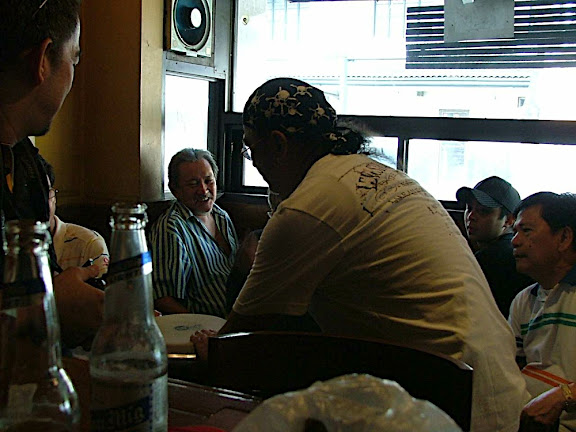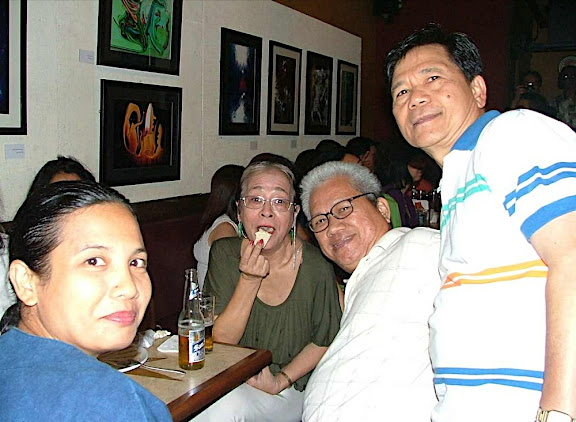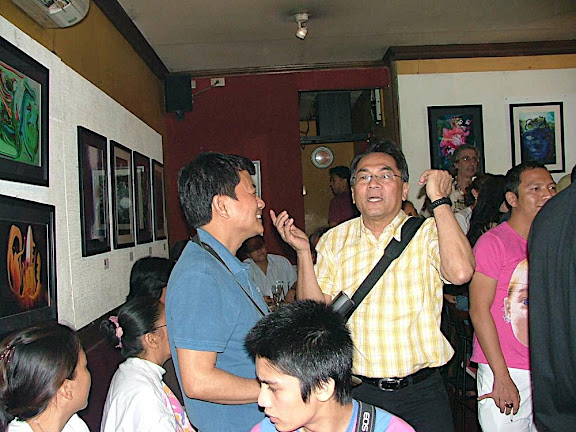



 From Top: Edd A in a huddle with Krip Yuson and Tante Tagamolila before the opening of Digitalla Prima; Pamela Grace Bañez, Sylvia Mayuga, Heber Bartolome, Tante; Claro Cortes and Jimmy Flor Cruz, and part of the huge crowd for the rather diminutive Oarhouse; and punong abalá Anabelle Bosch, Wally Gonzales, Marne K, Ronnie Lazaro, Ben Razon;Glenn Bautista, EddA, Tante.
From Top: Edd A in a huddle with Krip Yuson and Tante Tagamolila before the opening of Digitalla Prima; Pamela Grace Bañez, Sylvia Mayuga, Heber Bartolome, Tante; Claro Cortes and Jimmy Flor Cruz, and part of the huge crowd for the rather diminutive Oarhouse; and punong abalá Anabelle Bosch, Wally Gonzales, Marne K, Ronnie Lazaro, Ben Razon;Glenn Bautista, EddA, Tante.❞
Continuing the thread
Post No. 11: "Mahal ang pamasahe"
Wow, Junsy,
Great yung seminar mo. I bet those Whites, Blacks and Latinos were listening openmouthed to a Brown one from our own shores. Since I am an avid amateur, I would have liked to have been in the audience, kaya lang ang mahal ng pamasahe! Congratulations, Sir!
Marne
Post no.12: “Poets don't have friends either... but All You Need is Love!”
Ben,
Don't worry about photography or photographers having no friends. Poets don't have, either. But when we (photogs, poets, painters, musicians, digitalists, analogists) get together, aren't we easy to please? Viva San Miguel! At sana mabili mo na ang iMac mo! Ganda nung "Makati" picture mo. I will try to find a place for it in the ezine.
Tama ka, a good part of the nourishment of our art comes not from only from our fellow practitioners (although their insights, practice and anecdotes of their work are extremely important, I think, especially if they want to share them with us), from other arts and disciplines. I read as much philosophy, history (recent and ancient), and some economics (I'm trying hard to understand it), to feed my own way of looking at the world, so that I can competently talk about it. Or find meaning in it through my art.
But... when art occurs, it can even be in photography, even if, as you say, it is (originally at least) "simply a visual document produced by a person holding a machine." Remember, the easel-and-brush are as much machines as an architect's Pantograph, or your/our Nikons and Fujis. What matters is the creative process, which is present whether an image is being invented or copied from life, or reproduced, recomposed either as a chronicle or document, or as a comment on life. But all documents cannot always be "pure" ones (non-committal, indifferent). The process of composing them (which is selective) is already a comment on the ingredients and elements that the artist, photographer, or writer is putting together.
When you say, "Unless it's clear that what I see in photographs are a person's vision or their stamp..." then, art has already happened.
It is natural that we have to undergo a transition from one mode of operating, recording or perceiving (or the creation of art) to another, like what's happening now between analog and digital. There will always be pain and anguish. But there will always be different modes and discourses, defenses and differences.
Here's my take: the analogue mode is perhaps the ultimate stage of the Industrial Revolution, when all machines imitated the human body. Machines (say, the Letterpress) replicated the human limbs and joints and elbows; or all the knobs and cranks were fitted to the shape of hands and fingers; mobility and transportation technology imitated the human walk, then the sprint, then the flight of birds. Technology in this stage of development, had to be "organic," imitative of the human organs. Even thinking was converted into hands (like the clock so we can reckon or "conquer" time), or the technology for mobility was imitative of the feet (like the wheel so we can conquer distance), or the airplane wing for the bird wing, etc. Or, the analog camera, which is imitative of the eyes (the camera lenses for the eye's retina and single lens, the shutter for the irises, the aperture for the pupil--or the other way around, you have to correct me).
Now, digital (or electronic, etc.) technology I think is simply the next step. It doesn't even surpass, but includes, or improves upon, analog technology. The main difference? It is no longer just imitative of the human body, it is imitative of the human mind (where everything is virtual). The "real" is flesh, bone, and stones, while the "virtual" is the impression, the ghost image, of all these. The typewriter imitates the writing hands, but the computer (keyboard and CPU) imitate the brain. The writer thinks and types at the typewriter, but the computer "thinks" (processes) together with the writer. The typewriter and the Letterpress (and Offset) imprints on paper what the writer has thought through, or the photographer has caught and composed in his camera, the computer and imaging machines "catch" the inputs and process them and output impressions (images). When they put IC chips in the camera, it also started to "think." It could process and store virtual images (sure, the analog stored on film, light burned or altered the emulsion on film to create the image made of dots or grains, while digital "computed" with ones and zeros to create pixels). Analog also processes, but at the speed of hands, but digital processes almost at the speed of mind (or light). Or put another way, analog is mechanical and chemical (physical force and chemical reactions), while digital is electronic, as in electronic impulses.
Again, after all this, what counts is the result (or in the "impersonal" terminology of computers, the output). Art can be created in both, if the result creates both meaning and meaningfulness. Eventually, it will not be as impersonal as we might nostalgically think. Because, the brain which the computer imitates, is also a human organ. Humans are always "processing" the world in the act of deriving meaning from it (because in the daily simultaneity of events and experience, the world appears chaotic, meaningless and contradictory—good and evil, life and death, exist side by side without rhyme or reason). When we "process," with the implements of reasoning, we are trying to organize a chaotic world, we are trying to put sense into it. This has always been the human, existential, dilemma, to try to live meaningfully in an apparently meaningless world. Our implements and machines are important only inasmuch as they help us in creating meaning and meaningfulness. Death, because of its mystery and fearsomeness, negates the meaning of life. But Life is even as mysterious as death. All our art, in the end, is towards the uncovering of this mystery. When we "understand" death as well as life (one in the same in most religions), we affirm and insist on our life and meaningfulness.
And the governing motive of our search for meaning, which is also our means for conquering chaos and meaninglessness, is, as the Beatles said, love. All you need is love... Beauty, joy, meaning, order out of chaos, the integration of diversity, the creation of art, springs from Love, the coming together of all human faith and hope. And art, the creation of beauty, is Love's original and ultimate expression. Love is all you need.
Happy Valentine!
Marne
 Ermita by Ben Razon
Ermita by Ben RazonOne more photo, and a few lines
[Ben posts one more photo and I banggâ it with a poem, and here pauses the continuing thread of the Banggaan letters...]
Ermitang Halumigmig
Dumidikit ang lamig
sa pitsel at mga baso,
isang manipis na tela
ng halumigmig
sa gitna ng mainit
na hininga ng Ermita,
na naghihintay na lamang
ng dampi ng labi
ng mga lasenggo
at kung minsa'y mapulang
lipstik ng kaharap
na kagandahan, kung
multo man ito
ng mga buntong-hininga
ng lumipas, o kislap lang
ng ilaw ng bar
na matagal nang
nilisan ng pag-ibig.
Liquid Ermita
The cold clings
to the pitcher and glasses,
a thin gauze
of moisture
in Ermita’s hot
breath, awaiting
tipplers’ lips,
or perhaps the red
lipstick of the pretty
shadow across the table,
be she the ghost
of sighs past,
or just a sparkle
of bar lights
long abandoned
by love.
(MLK)









No comments:
Post a Comment